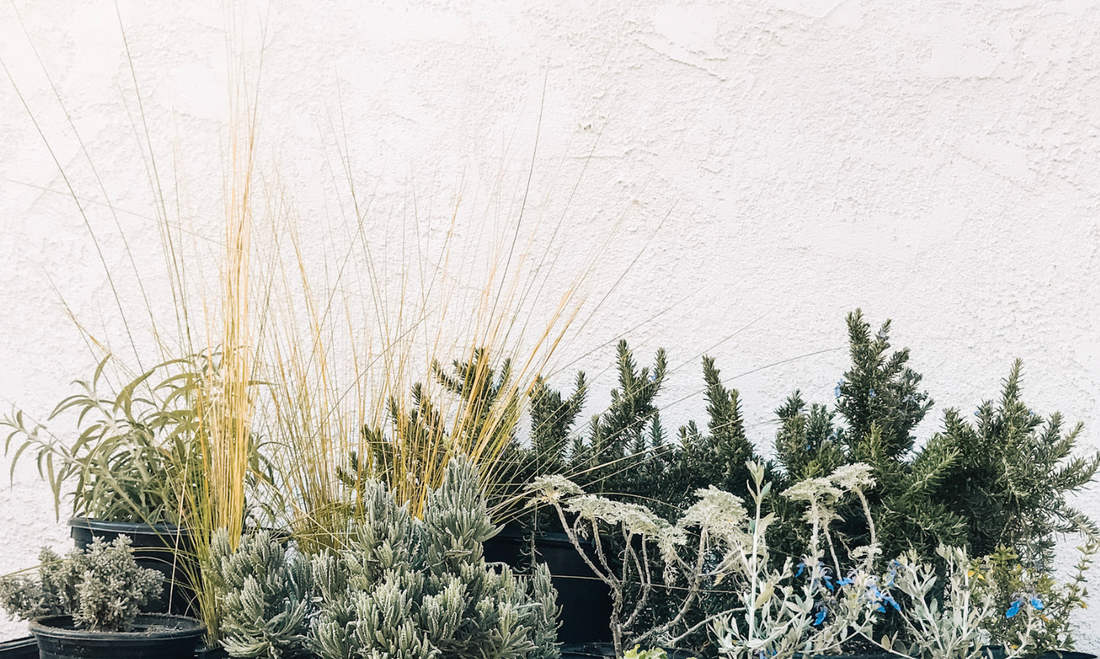Read on to find 4 straight-up lawn replacement options (that require half the water or less) PLUS 7 of my best drought tolerant landscaping tips.
First off, I want to explain all the reasons behind why I recommend these options. And why it matters you don't just pave or cover your yard in gravel (it actually costs you water in the long run).
There are lots of options for replacing a lawn. You can use something that looks and acts like lawn but requires half as much water. Or you can alternate pathways and open areas with lush low-water gardens. You can lay out a more formal garden with rows and clean geometry. Or open space light leafy trees over a courtyard-type area.
And, as mentioned, you can forego gardening altogether and pave. Or cover the ground with artificial turf aka fancy plastic. This seems like it cuts down on your water needs. But, it heats up your yard. And prevents rainwater from absorbing. And kills off surrounding plants from the overheating and soil compaction. Over the long run paving, large areas of gravel w/out many plants and artificial turf all exacerbate drought and heat.
Replacing Your Lawn with Native or Drought Tolerant Planting REALLY Matters: According to the California Regional Water authority, native plants survive drought happily with 20 gallons of water per month (you're likely to use just as much water a month hosing off concrete). While keeping a lawn green in summer (or even close to it) can take as much as 4,100 gallons of water per month per yard!
Native & drought-tolerant plants SAVE water by massively reducing soil temps. This increases the soil's ability to store water. And nutrients. Once top soil builds up it becomes like a sponge, soaking and retaining lots more moisture. Further increasing the habitat's drought resilience and overall lushness.

Large shrubs and tree's break up hardpan with their roots. Allowing excess water to infiltrate back into California's vast network of underground aquifers (which get depleted from lack of water infiltration caused by paving and soil compaction). The shade of large shrubs and trees adds to cooling the immediate habitat. Reducing air conditioning needs by %50 if planted within 30' to the South or West of the structure
TIP: make sure you choose trees that won't damage your foundation and grow very slow and/or less than 30' tall so pruning isn't overly costly (we always do!).
Large areas of concrete, gravel and artificial turf do the opposite of saving water. They further desertifies our climate. Minimal planting is not enough. Paving, gravel and artificial turf deplete soil moisture, prevent water absorption into the ground and heat the surrounding areas. By as much as 10 F!
This is why I advocate for gardens designed with good plant density: to cool the ground and increase soil moisture retention. It also crowds out weeds! And offers habitat for beneficial wildlife (like praying mantis and small birds).
So your lawn's dying and you want to replace it?

With something that still looks and acts like lawn??
These are the best options for Californian's who still want lawn but want to cut back on water. AND have something that can still survive with the watering restrictions occasionally mandated by summer drought.-
GROUNDCOVER OPTION: Kurapia IS it. I market it as "Alt Lawn Ultra" because this stuff - tho expensive b/c it's Japanese venture capitalist controlled - is the future of California's green spaces. It's a hybridized version of a California native groundcover. It roots down 10 feet so it doesn't need water at all in winter and can survive on watering 1x a week in summer (though it looks better with more). Naturally stays 2" high in sun so NO MOW. A little taller and whispier in shade. Crowds out most weeds (not nut sedge unfortunately). Currently the most popular ground cover in Japan. Also used to grow up dirt walls/stabilize extremely steep slopes. Heavy blooming in Spring attracts bees - can mow flowers off if it's a problem - but not recommended for those with serious bee allergies or aversions
-
NATIVE LAWN OPTION 1: California Native Lawn - the lowest water option is San Diego Bentgrass / Agrostis pallens. It does get brown patches in summer (goes seasonally dormant) but it greens back up with rain/cooling weather (when you actually want to go outside). Leave it full length (maxes out at 1') for a low-water meadow. Mow it like a regular lawn to 2" but needs more water at a shorter length. %30-50 water or less of conventional lawn. Can even be used by golf courses!
-
NATIVE LAWN OPTION 2: California Native Fescue Blend - also a grass to leave long - lusher and better for shade. Not as mowing friendly but tops out at 1' and looks clean and romantically sweepy. %50 water of conventional lawn.
- OTHER GROUNDCOVER OPTIONS: Groundcover mixes - there are a lot of experimental groundcover options to try for lawncover. So far not a lot them have proven to universally hold up for long to wear and tear. Silver carpet, yarrow or thyme work well for some. Especially in small areas. Blending different types of groundcover will provide a lot better coverage than just one due to their seasonal fluctuations in growth rate.
With drought tolerant or native plants??

YES! Here are seven tips for water-saving gardens in California.
TIP 1: Plant thick and diverse. Space plants 1-3 feet. Include at least 5-10 different species. This way you don't end up with lonely dry plant islands in weedy mulch. AND your soil is better shaded and thus will retain waY higher moisture content.
I know, it's counter-intuitive to think that more plants can mean less water usage, but take a second and think about how nature works: how does a forest establish? First it builds up organic matter (mulch, top soil, sticks & stuff), then it builds up plant density and diversity. Diverse communities = resilience.
TIP 2: Ensure your soil is fast draining for the happiest lowest water garden. Especially if you favor the lowest water native plants like ceanothus, penstemon and manzanita. If your soil cracks open when it's dry, you need to amend it heavily with fast draining media.
TIP 3: Light touches of soil improving media never hurt! We recommend worm castings and azomite. Or light compost additions mixed with cactus soil. If you can afford mycorrhizae inoculants get 'em in there! Give your soil life... it's probably been sittin' there machine compacted and unloved for over half a century.
TIP 4: Freely blend plants use almost any mediterranean-climate species with your California natives. They are similarly adapted for long summer droughts. These includes plants from the Mediterranean region, South Africa, Australia and Chile.
See examples here: https://calwildgardens.com/collections/rebate-qualifiers
TIP 5: Stick with mostly silver leafed plants for something easy that looks good. A LOT of drought tolerant plants have adapted to heat by becoming light shiny and reflective. A flower palette of purple, blue or lavender flowers with just a few yellows, pinks or oranges always looks great.
TIP 6: Can you get a lawn replacement rebate? If your lawn is still alive. You can likely qualify for a rebate. Contact your local water authority for details on their incentive programs. Or check out my article on rebates by clicking here.
TIP 7: Create more areas of partial shade: If you live where it gets really hot - like more or less desert - planting under shade will give plants that might not normally thrive there more heat tolerance. Can you plant a few plants to make more part or dappled shade where soil temps naturally stay 10-20 degrees lower? Make areas less open/broadly exposed to the sun by planting trees like Palo Verde, desert willow, grevillea or Olive.

Yards like this do fine on once to twice a week waterings during the hot seasons of the month *with* a little extra for fruit trees. Once trees grow into full-size and make more shade even more so.
BONUS TIP: Grey Water. Is it easy to convert your washer to a laundry to landscape grey water system? You can pipe your laundry water out to mulch pits and plant fruit trees or thirstier things near them. What makes it easy? is your washer already on an exterior wall? Do you know a laborer even moderately experienced with plumbing or irrigation? No permit necessary for installing laundry grey water systems in California.

About the Author: Hi, my name's Briana Lyon. I'm a veteran sustainable, California native and drought-tolerant landscape designer from Los Angeles. Whose also worked lots in the San Francisco area & even Canada! I've designed 100s of water-saving gardens & replaced A LOT of lawn. I created this eco-chic landscaping boutique to make the latest low-water landscaping products and practices readily available to the general public. Click the link to check it out: California Wild Gardens.





